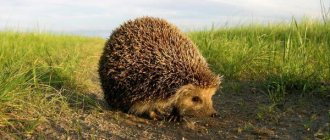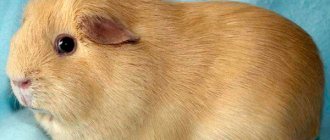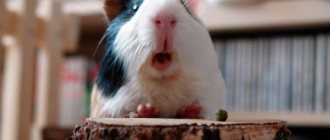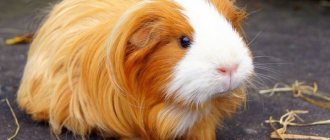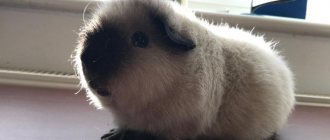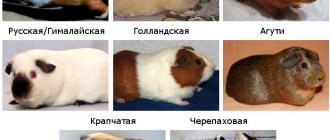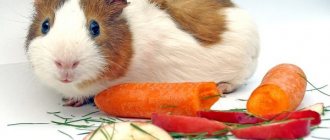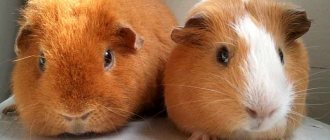How a rodent received the “title” of artiodactyl
First, let's look at the origin of the name “pig”.
When the Spanish conquistadors reached the homeland of future pets (the Andes in South America), the local population bred rodents as livestock (in other words, “for meat”). And it is not surprising that they were first seen in the form of a dish. The carcass of the animal really resembles a suckling pig. This is where the name “pig” comes from. This is the most realistic version of the appearance of the name.
By the way, in Peru you can still find Cui (the local name for guinea pig) on the menu of catering establishments, although this is not as common as in the time of Columbus.
Behavior
Cavias are school animals. The flock consists of 10 to 25 females and one male. The flock lifestyle is due to greater survivability and convenience for all members of the pack. Someone in the family must always be on guard while other members may be feeding offspring, storing food, or simply sleeping. Rodents cannot survive alone in the wild. Animals in a flock allow each other to rest. In case of danger, the “watchmen” make alarming sounds.
Small animals can make a wide range of sounds. With their help, communication occurs in flocks. A soft purr or sullen grunt allows the inhabitants of the flock to understand how their neighbors feel about them.
Wild pigs are clean animals in nature. They need to take care of cleanliness to avoid predators.
Within the pack, females live peacefully. They take care of the babies and each other together. Quarrels can only occur between males. They fight for leadership in the pack. The losing male must leave the pack and leave the territory. Having left the old family, the animals organize their own pack.
Additional versions of the name appearance
Even when alive, a guinea pig looks like a piglet, except that it has no heel:
- Disproportionately large head
- Droopy ears
- Short legs
- The shape of the body is similar to that of a pig
On the other hand, if people named newly discovered animals after already known ones, then there would be big problems with diversity. Therefore, the version is doubtful.
A more plausible theory states that the animal is so named because of the sounds it makes. When the pet is happy, it grunts - very similar to a young pig. And when scared it makes a pig-like squeal. Based on these analogies, the name appeared.
Yes, in this form the similarity is obvious.
A pet
Guinea pigs have long become perhaps the most familiar inhabitants of a living area.
They are very peaceful and fun to watch. Experts recommend keeping these animals in families (3 females and 1 male). You can have one animal, but then the owner must communicate with his pet more often, otherwise he will get bored. For several animals you need a fairly large cage, since each one needs a space of 40x40 centimeters. Cages with a deep plastic tray and a top made of metal rods are convenient. Sawdust or hay is placed in the tray as bedding. Guinea pigs produce a lot of urine, so bedding needs to be changed more often. The cage should be placed where there are no drafts, otherwise the pigs will often catch colds. They definitely need to build a house to sleep in. Every day the animals should be given the opportunity to run freely around the apartment. From lack of movement, they grow long claws, which, growing into the pads, cause pain. Pigs will feel comfortable in a house at a temperature of 16-18°C and a relative air humidity of 50%. If in the summer you can take your pet out onto clean country grass and give him the opportunity to graze, he will be very grateful to you.
How a pig became a guinea pig
We've sorted out the pig-likeness, but what about the sea? Not only do guinea pigs not swim, but they also don’t like water.
The simplest explanation here is that the ancestors of modern domestic animals were brought from overseas. So they called them overseas, sea. The same name for rodents in Polish and German.
This theory is partially confirmed by the name Guinea pig, because. in those days in England, everything that was imported from overseas was called “Guinean”.
This requires some clarification: Guinea is in West Africa, and the Kui originated from South America. Here, as in the entire history of overseas rodents, there are no simple answers. The most common explanations are:
- The word "Guinean" was used to mean "overseas"
- Guinea is similar to Guiana (a French colony in South America), so there was confusion
- Guinea pigs initially cost exactly 1 guinea (English coin), hence the nickname.
Nutrition
The basis of the diet is hay (about 80%). Since hay may contain dust, it is better to serve it to the animal in a special hay dispenser, which you can make yourself or buy at a pet store.
By the way, hay should not be gray in color: rotten or moldy hay is unsuitable for food. You can avoid this by not pouring water into a regular bowl; use a special water bowl for rodents. Of course, it is worth giving additional fruits and vegetables, grains, bran, as well as feed additives sold in pet stores. And remember that these rodents cannot produce vitamin C, so they need berries and fruits high in vitamin C. This includes:
- oranges
- lemon zest
- parsley
- broccoli
- kiwi
- bell pepper
- Brussels sprouts
- water with rosehip infusion (periodically)
It is recommended to feed this cute rodent three times a day and change the water daily to prevent it from stagnating.
But these animals also have prohibited products :
- any meat
- onion and garlic
- any conservation
- beans and firm peas
- corn
- beet
- hot peppers
- Potatoes are poisonous!
- nuts (high in fat)
- sunflower seeds (also have a lot of fat)
- avocado
- milk (pigs are lactose intolerant)
- cheese or cottage cheese (too fatty, contains lactose)
- anything containing industrial sugar (chocolate, cookies, etc.)
- all salty foods (salt crackers and bread)
And remember that all vegetables suitable for pigs cannot be boiled. Give vegetables raw. It is ideal to feed by the hour, since rodents in this regard are similar to most people and wait for food at the same time. What else should we not forget? There should be hay in the guinea pig's house at all times, fruits should be given about three times a week, vegetables - 200 grams every day for each animal. Additionally, it is permissible to give out a handful of granulated food daily.
Interesting facts about guinea pig breeding
Any breeding of animals should be taken seriously and should be done by experienced breeders. This activity is definitely not suitable for children or teenagers, since in case of complications, the pig will need to be urgently taken to the veterinarian and paid for a medical examination. It is important to remember that too many guinea pigs are left homeless simply because they have been the victims of inexperienced owners.
The duration of pregnancy for guinea pigs is 60 - 70 days. During pregnancy, the animal needs to be fed up to four times a day. Females are allowed for breeding only at the age of 4 - 5, if possible 6 months, and males - 6 - 7 months. Labor usually lasts within 30 minutes. It is difficult to predict the number of cubs, because from 1 to 6 individuals can be born. After giving birth, the mother pig eats the babies' placenta and licks them thoroughly so that they do not freeze. In the wild, this is an important protective instinct to avoid attracting predators who can smell blood well from a great distance.
The little cubs are born with their eyes open, completely covered in fur, and can stand on their feet within an hour of birth. In the first days, babies feed on mother's milk, but after 4 - 5 days they can already eat adult food (some even earlier), alternating it with mother's milk during the first three weeks of life. And although pigs are already sexually mature by three months, they fully grow within a year.
How long do guinea pigs live?
With good care, guinea pigs live 6 - 8 years . It is worth saying that some individuals can live up to 10 years . The oldest guinea pig named Snowball (from England) was registered and entered the Guinness Book of Records in 1979, having lived to almost 15 years. If you take into account all the advice, apply the recommendations on the correct maintenance of a guinea pig, and also treat it in a timely manner, then your pet will delight you with its presence for a long time and will give you and your family many pleasant emotions.
Version of the priests' conspiracy
In an attempt to circumvent the restrictions on eating meat during Lent, Catholic priests came up with all sorts of things. So cavy (another name for our pets) was included in seafood.
Of course, it was difficult to do this unnoticed. Therefore, they came up with the following reason: cavy were imported along with capybaras (rodents with a semi-aquatic lifestyle). On this basis, the priests classified pigs as... fish. And they decided to call them sea - to explain their actions.
The story may seem crazy, but many foods from the New World bypassed the prohibitions on consumption during Lent. For example, cocoa, although it can hardly be considered an abstinence food.
The simplest explanation
The simplest explanation for the origin of the name “guinea pig” is that the first sailors who reached the animals’ habitats adopted the experience of breeding them from the local Incas. And on the return trip they were taken to the ship (usually “standard” European pigs were taken on the trip and kept in a pen in the hold).
Rodents are friendly, can eat dried vegetation, do not take up much space, and produce much less waste. So they replaced the usual grunts on the Spanish ships. The name, based on the circumstances, is the most logical.
But everything changed upon arrival in Europe. There were few animals left, they were highly valued (as a curiosity), and it was more profitable to sell the remaining animals instead of using them for food. This is how the food animals migrated from the galley to the living rooms of aristocrats.
The owner calls him a pig so often that it’s better to hide before the New Year.
Description of the rodent
— Advertising —
The body length of a guinea pig is 25-35 cm depending on the breed, the body is round in shape, there is no tail, the ears are hanging, the muzzle is wide and blunt. The weight of an adult male ranges from 1 to 1.5 kg, the female usually weighs a little less, from 800 to 1200 g. The natural color of the guinea pig is brownish-grayish, the tummy and paws are light on the inside.
Other names for guinea pigs
We have already mentioned the names Kavi (Kavi, Kavia), Kui, Guinean - in different countries the animal is called differently. It remains to remember that they haven’t named it yet.
The official scientific name in Latin is Cavia porcellus. The first part is derived from the local name of the animals. The second literally means “pig”.
In the UK the most common name is Indian pig. In Spain - Indian rabbit. This is due to the fact that open America has long been considered India. In some Western European countries, the pig is called Peruvian.
Reproduction
Cavia females bear offspring 2 to 4 times a year. They can carry up to 8 piglets at a time. Mating often occurs in the summer, because at this time the weather conditions allow the babies to feel comfortable and grow. Little pigs begin to eat and walk on their own already on the 6th day, and after another week they become completely independent animals. Early independence is due to the presence of a sufficient amount of food, which is located near the nest, as well as the presence of teeth and warm fur.
Modern guinea pigs
Today's pets are very different from their wild ancestors. In nature, Cavias are brown with a slightly lighter belly. “Home” colors are much more fun: black, white, red, pearl, two-color, three-color... Almost any.
According to the type of wool there are:
- Longhair
- Shorthair
- Wirehaired
- Hairless
You can read more about the breeds in a separate article on our website.
There is a color to suit every taste.
Appearance
Wild guinea pigs are different from their domestic counterparts. They are more active, weigh less and have stronger muscles. This difference is determined by the need to independently obtain food for themselves, hide and run away from predators. The animals react to the appearance of danger with lightning speed; in a split second they are ready to take off, jump high, climb a tree trunk and dig a shelter for themselves, escaping from the enemy.
The coat color of these rodents combines gray, brown and black. This is necessary for camouflage. A fall from a height, which would end tragically for domestic rodents, does not pose a serious health threat to Kavia.
